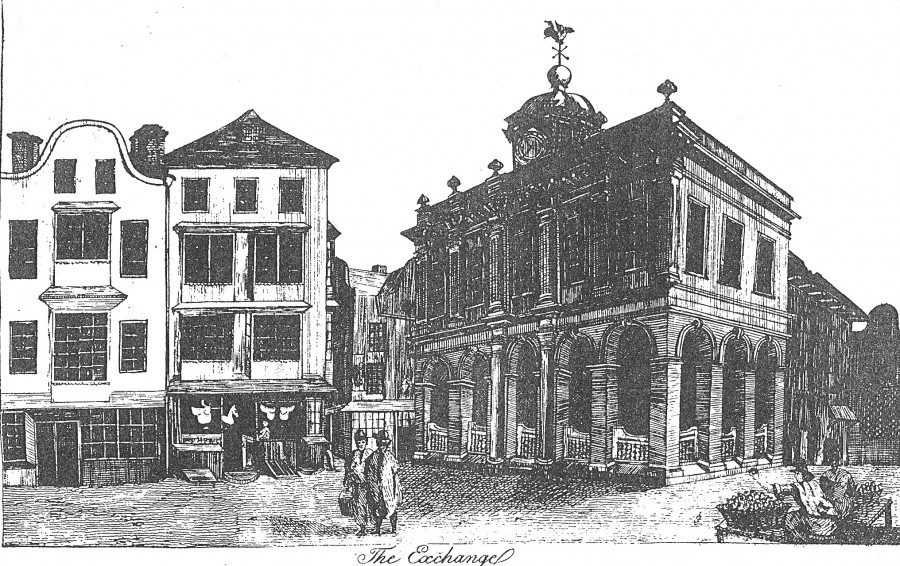
Kieran’s Our City, Our Town Article,
Cork Independent, 27 April 2017
Kieran’s May Historical Walking Tours
Early summer is coming and the weather is improving. So below are details of the next set of my public walking tours for the first week of May,
Tuesday 2 May 2017, Historical Walking Tour with Kieran of Eighteenth Century Cork, from the walled town to an eighteenth-century Venice of the North; meet outside Cork City Library, Grand Parade, 6.45pm, (free, 2 hours, finishes on St Patrick’s Street)
For nearly five hundred years (c.1200-c.1690), the walled port town of Cork, built in a swamp and at the lowest crossing point of the River Lee and the tidal area, remained as one of the most fortified and vibrant walled settlements in the expanding British colonial empire. However, economic growth as well as political events in late seventeenth century Ireland, culminating in the Williamite Siege of Cork in 1690, provided the catalyst for large-scale change within the urban area. The walls were allowed to decay and this was to inadvertently alter much of the city’s physical, social and economic character in the ensuing century.
One of the most elegant additions to eighteenth century Cork was the Exchange or Tholsel, which was built on the site of Roches Castle (now the site of the Catholic Young Men’s Society hall on Castle Street). It was an important building of two stories. On its opening in 1710 the Council ordered the upper floor room be established as a Council Chamber with liberty for the Grand Jury of magistrates and landlords to sit. The lower part was used for commercial purposes. where a pedestal known as “the nail”, was used for making payments (still in existence in Cork City Museum). In later times the room was used for public sales. A figure of a dragon made of copper and gilt surmounted the cupola of the building as a weather vane. The Exchange declined as a market in time – through the erection of a Corn Market on the Potato Quay (popularly known as the Coal Quay) and improved facilities for the transaction of business offered to merchants.
Wednesday 3 May 2017, Historical Walking Tour with Kieran on the Walk of the Friars, from Red Abbey through to Greenmount; meet at Red Abbey Square, 6.45pm, (free, 2 hours, finishes near Deerpark)
The central bell tower of the church of Red Abbey is a relic of the Anglo-Norman colonisation and is one of the last remaining visible structures, which dates to the era of the walled town of Cork. Invited to Cork by the Anglo-Normans, the Augustinians established an abbey in Cork, sometime between 1270 AD and 1288 AD. It is known that in the early years of its establishment, the Augustinian friary became known as Red Abbey due to the material, sandstone, which was used in the building of the friary. It was dedicated to the Most Holy Trinity but had several names, which appear on several maps and depictions of the walled town of Cork and its environs. For example, in a map of Cork in 1545, it was known as St Austins while in 1610, Red abbey was marked as St. Augustine’s.
In the mid eighteenth century, part of the buildings of Red Abbey were used as part of a sugar refinery. This refinery was burnt down accidentally in December 1799. Since then, the friary buildings with the exception of the tower have been taken piecemeal. The tower is maintained by Cork City Council who were donated the structure by the contemporary owners in 1951 and also own other portions of the abbey site. Today, the tower of Red Abbey approximately thirty metres high is one of Cork’s most important protected historic structures. The remaining tower cannot be climbed but medieval architecture can still be on the lower arch of the structures and in the upper windows. The adjacent street names of Red Abbey Street, Friar’s Street and Friar’s Walk also echoes the days of a large medieval abbey in the area.
Thursday, 4 May 2017, Historical Walking Tour with Kieran of Blackrock Village, from Blackrock Castle to Nineteenth Century Houses and Fishing; meet outside Blackrock Castle, 6.45pm, (free, 2 hours, finishes at railway line walk)
The earliest and official evidence for settlement in Blackrock dates to c.1564 when the Galway family created what was to become known as Dundanion Castle. Over 20 years later, Blackrock Castle was built circa 1582 by the citizens of Cork with artillery to resist pirates and other invaders. In the early 1700s, the prominent Tuckey family, of which Tuckey Street in the city centre is named, became part of the new social elite in Cork after the Williamite wars and built part of what became known in time at the Ursuline Convent. The building of the Navigation Wall or Dock in the 1760s turned focus to reclamation projects in the area and the eventual creation of public amenity land such as the Marina Walk during the time of the Great Famine. Soon Blackrock was to have its own bathing houses, schools, hurling club, suburban railway line, and Protestant and Catholic Church. The pier that was developed at the heart of the space led to a number of other developments such as fisherman cottages and a fishing industry. This community is reflected in the 1911 census with 64 fishermen listed in Blackrock.
Captions:
882a. Sketch of Cork Exchange, c.1750 (now the site of YMCA hall, Castle Street, one of the city’s primary market sites, subject of eighteenth century Cork tour (source: Cork City Library)
882b. Map of north east marsh, Paul Street & St Paul’s Church, 1726 by John Carty (source: Cork City Library)
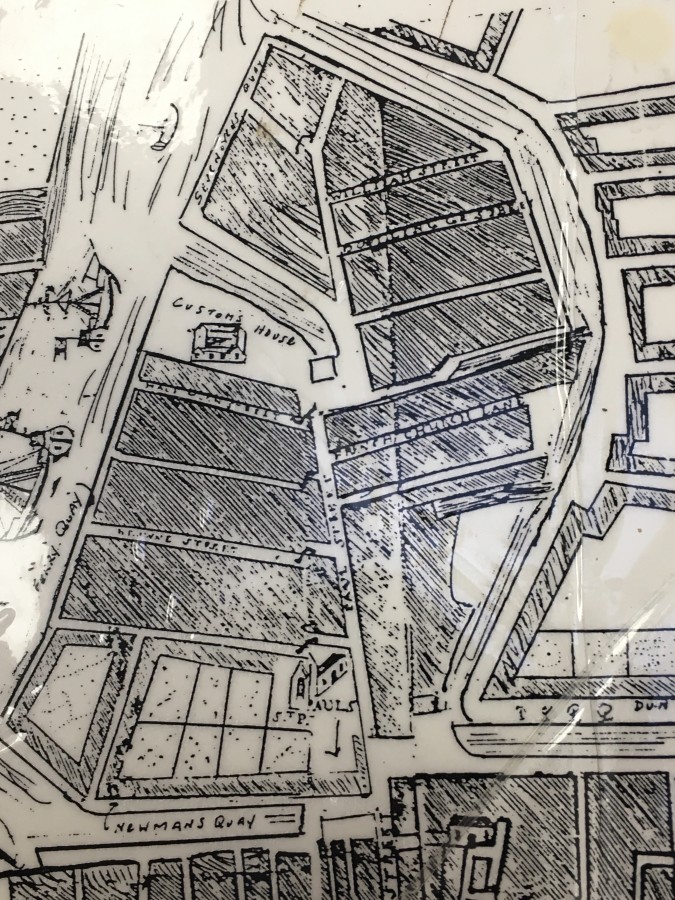
Independent Cllr Kieran McCarthy will give three historical walking tours in early May across the southside of the City.
Tuesday 2 May 2017, Historical Walking Tour with Kieran of Eighteenth Century Cork, from the walled town to an eighteenth-century Venice of the North; meet outside Cork City Library, 6.45pm, (free, 2 hours, finishes on St Patrick’s Street)
Wednesday 3 May 2017, Historical Walking Tour with Kieran on the Walk of the Friars, from Red Abbey through to Greenmount; meet at Red Abbey Square, 6.45pm, (free, 2 hours, finishes near Deerpark)
Thursday, 4 May 2017, Historical Walking Tour with Kieran of Blackrock Village, from Blackrock Castle to Nineteenth Century Houses and Fishing; meet outside Blackrock Castle, 6.45pm, (free, 2 hours, finishes at railway line walk)
Commenting Cllr McCarthy noted;
“It is said that the best way to get to know a city is to walk it – in Cork you can get lost in narrow streets, marvel at old cobbled lane ways, photograph old street corners, look up beyond the modern shopfronts, gaze at clues from the past, be enthused and at the same time disgusted by a view, smile at interested locals, engage in the forgotten and the remembered, search and connect for something of oneself, thirst in the sense of story-telling – in essence feel the DNA of the place”.
“Cork has a soul, which is packed full of ambition and heart. Cork is a city packed with historic gems all waiting to be discovered at every street corner. These three walks provide insights into the development of just three of the city’s historical suburbs”.
Independent Cllr Kieran McCarthy has called for continued engagement with local residents along Skehard Road as the various phases of road’s re-alignment are evolving. Parts 2, 3 and four are in various stages of development – some are part designed and awaiting funding. As part of phase 3, the Roads Directorate of Cork City Council plan to develop detailed traffic models at Mahon CSO junction. This will involve traffic counts, assessment of turning patterns, queue lengths, traffic demand etc. Cllr McCarthy noted; “the modelling will form part of a Council proposal to the National Transport Authority whereby it forms part of phase 3 of the large Skehard Road’s realignment and traffic management scheme”.
Phase 3 involves Skehard Road to be widened from and including the Church Road junction up to and including the CSO/ Mahon Link Road junction. An outbound bus will be introduced on Skehard Road between the Church Road junction and the CSO/ Mahon junction. An inbound cycle lane will be introduced on Skehard Road. All entrances to housing estates will be realigned and radii tightened to slow entry and exit traffic thereby making the area safer for pedestrian. Pedestrian friendly table top ramps will be introduced on the entrances to all side roads. The Bessboro Road junction and the CSO junction will be upgraded and realigned to improve its operation for the benefit of all road users. All traffic signals will be upgraded and real time passenger information displays installed. All bus stops will be upgraded and real time passenger information displays installed. Footpaths will be re-aligned repaved and widened where necessary. Additional public lighting will be installed where necessary. Soft and hard landscaping will be provided. Water mains and other utility will be provided.
Cllr McCarthy noted; “The widening of the road of phase 3 involves taking some land from residents along the phase 3 section. I welcome the fact that the Council has already been in contact with affected residents regarding compensation. Submissions by members of the public have also been received and points added in to the evolving project layout”.
Continuing Cllr McCarthy, “ultimately the completion of phases 2, 3 and 4 are dependent on funding being forthcoming from the National Transport Authority under the Regional Cities Accessibility Programme”.
Question to the CE:
To ask the CE for an update on the re-surfacing of Douglas Pool carpark and hill? (Cllr Kieran McCarthy)
Motions:
That the Council review the parking situation and road layout outside the shopping parade near the Silver Key bar. At present there is very little parking for the five businesses trading here. There can be a lot of congestion and illegal parking around busy times and this affects business and causes problems for local residents who are left with no option but to call the Gardai. A strip of cycle lane on the main road was formerly much used and greatly appreciated parking (Cllr Kieran McCarthy)
That the Council resurface the stretch of road outside Galvin’s Off-Licence on Douglas Road. It has been in a deteriorating state for many years now (Cllr Kieran McCarthy)
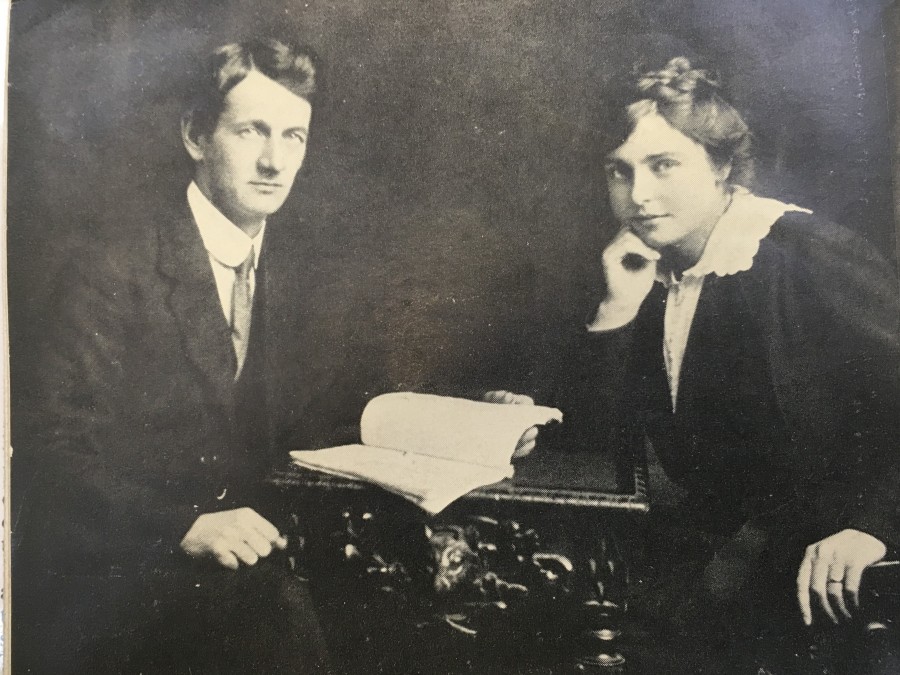
Kieran’s Our City, Our Town Article,
Cork Independent, 20 April 2017
The Wheels of 1917: The Volunteers Re-Organise
Easter 1917 coincided with the commemoration of the rising a year earlier. Up to early 1917, the Volunteer organisations appeared to have dissolved but release from English gaols saw companies of Volunteers re-organising and training. In January 1917, the Cork volunteers in their hall at Sheares Street began to regroup under Tomás MacCurtain. Close police attention led to MacCurtain’s leadership being short-lived as he was arrested again. He left behind two battalions which had been built up, comprising eight companies each. Demands were given by British Authorities for the closing of the Volunteer Hall. The Volunteers remained until the doors were closed by force on 4 June 1917 and several arrests were made.
MacCurtain’s arrest was not the only one in February 1917. Terence MacSwiney was also arrested and both were brought to the Military Detention Barracks, where two other Volunteers Sean Nolan and Peadar O’Hourihane were also present. On 23 February 1917, all four were taken to Arbour Hill Barracks in Dublin. Here they were served with deportation orders condemning them to be exiled out of Ireland for an unspecified period to small English towns, free to roam them but not to return to Ireland. Tomás and Peadar were sent to Ledbury in the County of Hereford, north of Bristol and MacSwiney and Nolan to nearby Bromyard. On Easter Monday 1917. they marked the first anniversary of the Easter 1916 Rising in Dublin in their own way. Terence and his wife to be Muriel Murphy were planning their wedding day for June 1917.
Meanwhile across the country, small volunteer companies marked the first anniversary. In Dublin, on Saturday 13 April 1917 the Sinn Féin flag of orange, green and white was hoisted over certain public buildings – the old Post Office wall near Nelson’s Pillar on O’Connell Street, the AOH (American Alliance) offices in North Frederick street, and Boland’s Mills. In O’Connell Street, large numbers of young people gathered and some were noted by police to have taken to the streets breaking windows and resisting police arrest.
A day later on Sunday 14 April in Cork it is recorded by the Cork Examiner that four hundred processionists, many of whom wore Sinn Fein badges and rosettes, marched from the North Cathedral to Cork City Hall. At the Cathedral, a memorial service was held for persons who were killed arising out of the 1916 Easter Rising. During the ensuing march, the Volunteers sang the marching song of the Sinn Féin volunteers and also an Irish version of Easter Week.
At City Hall, some persons had already entered the building, and hauled down the municipal flag replacing it by the Sinn Féin ones. The processionists sang Irish songs, saluted their flag and retraced their steps to the National Monument on the Grand Parade. The parade movements were watched by fifty police, under District-Inspector Walsh, who appealed to the ringleaders of the demonstration to disperse quietly. The police approached the mob with drawn batons and were received with a fusillade of stones. The police noted of the disorder that half the rioters were women, who served as a screen for the ringleaders. The police made a combined baton charge and dispersed the mob in all directions. The Sinn Féin flag was hauled down from City Hall by the police, but was later retrieved by Volunteers and was run up again and flew for the rest of the day over City Hall.
By Sunday 22 April 1917, Bishop Cohalan, sent a letter to the priests of the Diocese for his concerns about further rebellion to be read out following letter was read at each Mass in the City’s churches. He had concerns that on a few occasions after memorial masses, processions to the National Monument were taking place; “I am reluctant to interfere with liberty on the street. The stoppage of a procession or demonstration can easily become an undue interference with liberty…a procession from a Church does not necessarily imply irreverence to the Holy Sacrifice of the mass…But processions after the memorial masses would lend to conflict and disorder in the streets. And I appeal to you all, priests and people, to remember the reverence which is due to our place of worship, and, above all, to the Holy Sacrifice, and to see to it that there shall be no procession or demonstration which might lead to disorder, no matter by whom caused, in connection with the Memorial masses”.
Examples were made of Sinn Fein Volunteers by British authorities. The Cork Examiner on 26 April 1917 records the findings of a District Court-martial held at Cork Barracks into charges made against Patrick Higgins, 70 Dominick street, John Healy, 32 Evergreen street, and Jonnies Courtney. 95 Hibernian Buildings. The accused were charged with having on 7 March 1917 at the Sinn Fein Hall on Sheares Street, taking taken part in drilling without having a permit from the competent military authority. Each of accused was found guilty, and Higgins was sentenced to six months’ imprisonment with hard labour whilst Healy and Courtney each were sentenced to three months’ imprisonment with hard labour.
Cork 1916, A Year Examined (2016) by Kieran McCarthy & Suzanne Kirwan is now available in Cork bookshops.
Cork City History Tour (2016) by Kieran McCarthy is also available in Cork bookshops.
Captions:
891a. Terence MacSwiney and his wife Muriel Murphy, c.1917 (source: Cork City Library)
891b. National Monument on the Grand Parade, c.1917 (source: Cork City Through Time by Kieran McCarthy & Daniel Breen)
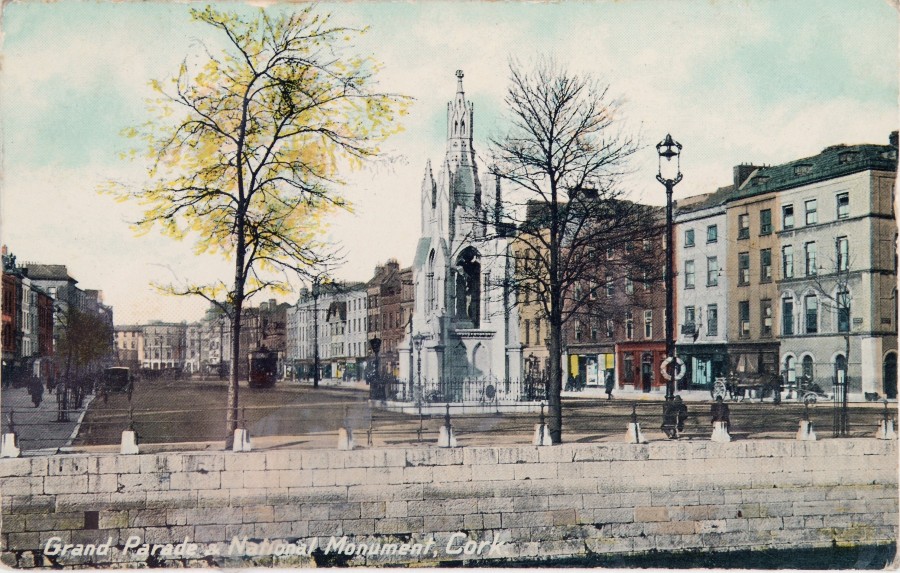
Cork’s young people in Blackrock and Mahon are invited to participate in the ninth year of Cllr Kieran McCarthy’s Community Talent Competition. The auditions will take place on Sunday 23 April 2017 between 10am-5pm in the Lifetime Lab, Lee Road, Cork City. There are no entry fees and all talents are valid for consideration. The final will be held on Sunday 7 May. There are two categories, one for primary school children and one for secondary school students. Winners will be awarded a perpetual trophy and prize money of €150 (two by €150). The project is being organised and funded by Cllr Kieran McCarthy in association with Red Sandstone Varied Productions (RSVP).
Cllr McCarthy noted: “The talent competition is a community initiative. It encourages all young people to develop their talents and creative skills, to push forward with their lives and to embrace their community positively”. Continuing Cllr McCarthy highlighted the strengths of the project; “Over the eight years of the project, many auditionees have passed through our doors – singing, acting and performing; we have tried to give young people pointers in developing their talents further; many are just taking the first step and many have carried on developing and enjoying their talent through local stage and performance schools; My team and I are very proud as well that several of our auditionees are now professional musicians, singers and even magicians with young careers burgeoning. Further enquiries/ details on the Community Talent Competition can be got from the talent show producer (RSVP), Yvonne Coughlan at rsvpireland@gmail.com.
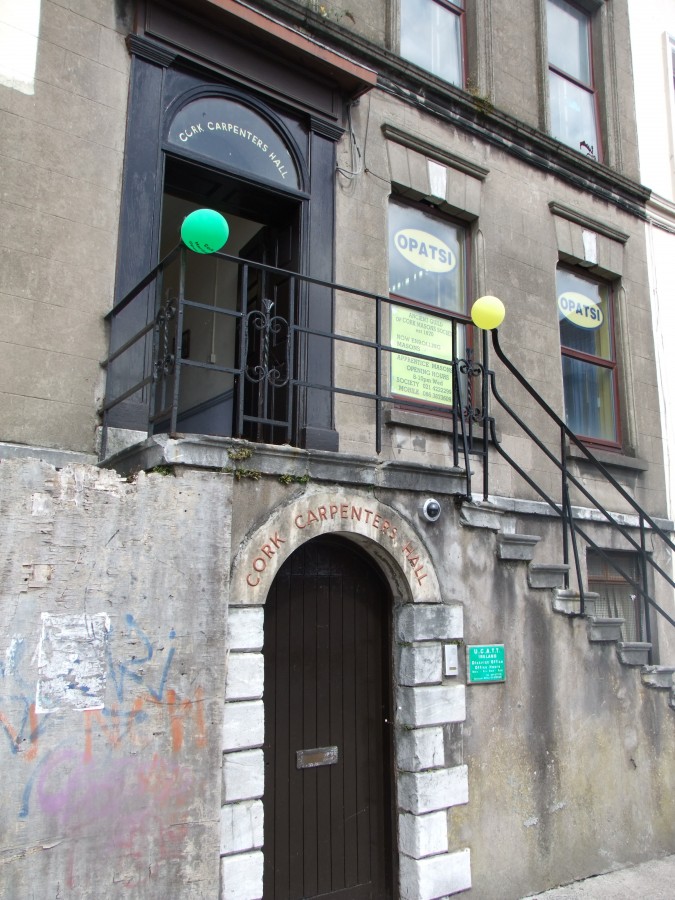
Kieran’s Our City, Our Town Article,
Cork Independent, 13 April 2017
The Wheels of 1917: The Carpenter’s Call
The history of Cork unions and the labour movement is not an overly researched topic in Cork history, but relationships between employers and employees regularly appear in the newspapers across the years. This month, one hundred years, coincided with strikes and union meetings in the city. A dispute on pay between the Cork Carpenter’s Society and the Builder’s Federation was ongoing. A fully attended meeting of the Builder’s Federation was held on 2 April 1917 with the proceedings being private. The situation was discussed at length and the meeting approved of the reply drafted to the declaration of the carpenters. A Cork Examiner article on 3 April 1917 reveals that it was hopeful that the matter would be resolved: “a much more hopeful aspect is believed to prevail, and the hope is expressed that the spirit of broadmindedness, which is being displayed on both sides at present will have a good effect; the time is ripe for mediation, and that it would be a great pity if the present favourable opportunity were allowed pass, with the danger of the delay giving rise to a more embittered situation”.
The members of the Cork Masons and Plasterer’s societies also struck work on 2 April 1917, the former on a demand equivalent to an increase of 9s a week in their wages, and the latter equivalent to an increase of 6s a week. Both bodies pointed out that their claims were made independently of the Carpenter’s Society. The builders’ attitude in reference to the masons’ demand was that they were prepared to grant them a war bonus of 3s a week and an increase of wages represented by 6d a day subject to a guarantee, to abide by certain modifications of rules. They offered similar terms to the plasters as from 2 April and promised that when “certain matters in the course of settlement with another trade body” were adjusted, their demand would be fully considered.
A week later, the masons, plasterers, builders’ labourers, and munition workers on strike attended public meetings hosted by the Lord Mayor, Thomas C Butterfield to speak about arbitration measures. At the meeting of 8 April it was discussed that the men involved have already appointed their arbitrator, and the masons would soon appoint theirs. The Chairman, Mr P Lynch, was glad to be able to announce that negotiations were proceeding with a view of bringing the dispute to an end and breaking the resolve of employers in the building trade; “If the employers in the building trade had been left lo themselves he was convinced that there would have been no trouble between the men and employers, but unfortunately outsiders intervened and tried to force the employers in the building trade to smash the men’s union. I trust that the men would be able to return to work next week after winning a successful but short fight”. On the motion of Alderman Cllr Kelleher, a resolution was unanimously adopted, hailing the attempts being made to bring about an amicable settlement, between employers and employees.
By 16 April 1917, the outcome of many discussions was that a joint conference of the representatives of the South of Ireland Master Builders Association and the Amalgamated Society of Carpenters and Joiners under the chairmanship of Captain Fairbairn Downie at 4pm, at the Cork National Shell Factory on Corn Market Street, now the Bodega. After an exhaustive discussion of all the phases of the dispute, arbitration under Captain Downie was unanimously agreed to. The employers present were Messrs T Goodall of Cork Timber and Iron Co, Ltd and William O’Connell, of Messrs W O’Connell and Son and Charles F Hayes of Messrs Meagher and Hayes.
On 30 April, Captain Downie published his proposed award scheme, which did settle the dispute; Working hours to work were to be from 8am to 6 pm from Mondays to Fridays inclusive with an interval of one hour from 1 pm to 2 pm for dinner. Working hours on Saturday were to be 8 am to 1 pm; all carpenters and joiners would work 50 hours per week. Overtime from 6 pm to 9 pm was to be paid time and a quarter. Half an hour for refreshments was to be allowed, and the time to be mutually agreed upon. From 9 pm to 12 midnight was to be paid time and a half, and from midnight to 6 am, was to be double time, with one hour break by arrangement. The rate of wages was to be l0d per hour as and from the 1 April, 1917, until the first day of May, 1917. From that date the wages were to be increased by a further halfpenny per hour, making a total rate of wages from that date to be 10½ d per hour all the year round. Country money was to be paid at the ratio of 1s 3d per day. The sum of 3s was to be added if working on two different jobs in the one week. Train fares to and from jobs were to be paid by the employer. However, a workman leaving his job in the country without permission, or through misconduct, was not to be paid his return fare.
Captions:
890a. The operative society of Masons & Bricklayers have been residents of Carpenters Hall on Fr Mathew Quay since 1950, before that they were residents in Mechanics Hall from 1870, which was used by the volunteers during the Irish War of Independence (picture: Kieran McCarthy)
890b. Carpentry tools on display at Cork Carpenter’s Hall during a recent Cork Heritage Open Day (picture: Kieran McCarthy)
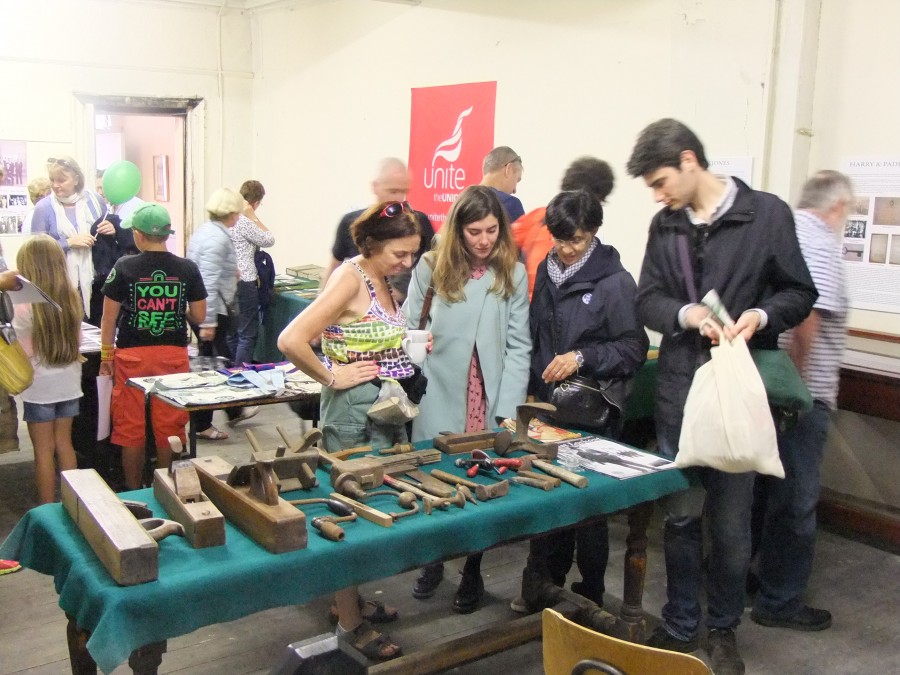
Independent Cllr Kieran McCarthy has welcomed the decision by Cork City Council Library Service to join the Sierra National Local management system. The Council’s data for stock and for patrons, to is now contained on a national system, in terms of acquisitions, catalogue and circulation of books. Cllr McCarthy noted though that despite the potential of accessing books from across the country there are still some areas to bed in. “Some concerns have been raised by the Council’s library service and City Librarian. The SMS messaging system for patrons is not yet working in a satisfactory manner. There are concerns about data protection – incorporating personal data taken from the City Council database and incorporated into a national database. There are unnecessary restrictions on teenagers seeking to borrow books for e.g school projects. There is uncertainty about the new fine system. An unnecessarily high limit on items, which patrons may reserve (12 items)”.
Cllr McCarthy has called for ongoing cost benefit analysis of the new system; “Early indications show a heavy draw on Cork City Council library stick from patrons around the country; for every two requested by Cork City library patrons. There are five requests for Cork City library’s stock by patrons outside of Cork City. However, to be able to get books from any part of the country is a great asset to have; it is just important that the burden of cost is properly funded at national level. Cork City Libraries have been under a lot of funding pressures in past years, with staff levels not being renewed due to cutbacks and libraries like that planned for Mahon not getting off the ground”.
Independent Cllr Kieran McCarthy has welcomed the decision by Cork Public Museum to join the Museum Standards Programme for Ireland. The Museum officially applied to the programme in September 2016. The Museum was accepted into the programme two months ago and thus began a 3-5-year process to achieve interim and then full accreditation.
Cllr McCarthy noted: “The Museum will need to survey and evaluate its current practices and structures in order to measure them against the standards and guidelines expected by the Heritage Council. This will determine areas of operation that need to be improved and professionalised. The process will involve a closer working relationship between the museum management and various City Council directorates. There will also need to be investment in staffing structures, equipment and building maintenance/ refurbishment to successfully meet 34 standards. Museum staff would have access to training and large bursaries and form part of a national network of participating and supportive museums/ organisation”.
Continuing Cllr McCarthy welcomed the potential of the programme in attaining national funding to protect museum collection plus the outreach potential. “Cork City Council has very good and dedicated curators operating the museum, who have created sterling exhibitions over the last few years and are real champions of Cork’s heritage. The programme will help increase our educational and social outreach capabilities that will form part of a wider agenda to make the city’s collections more accessible to all. This programme will help Cork Public Museum re-connect with the local community by becoming a place that local people relate to, participate in, engage with and ultimately be proud of. If local people visit and enjoy the museum, then tourists will follow”.

Kieran’s Our City, Our Town Article,
Cork Independent, 6 April 2017
The Victorian Quarter Walking Tour
My first public walking tour for 2017 returns to the Victorian Quarter – Sunday 9 April 2017, Historical Walking Tour of the Victorian Quarter, From Fever Hospital to Street Grandeur, meet at the green (Bell’s Field) at the top of St Patrick’s Hill, 2.30pm, free, 2 hours. The tour is part of the Lifelong Learning Festival.
In a world where globalisation reigns, more than ever place matters. The Victorian Quarter is a new branding by traders within MacCurtain Street environs and Cork City Council to describe a historic corner of Cork, which was built up during the time of Queen Victoria and espouses the good, the bad and the ugly of Cork History. One is dealing with immense scenic perspectives – book ended by the epic St Patrick’s Hill view to the west, Kent Station to the east and river and port frontage to the south. There is something to be said about how the street and buildings are carefully balanced and placed on a steep carved out sandstone ridge to the north – an important story of strategic engineering, which appears in earnest behind the waterfall feature behind Greene’s Restaurant.
The area comprises gorgeous, original and well invested architecture with rich stories. Its historical DNA is rooted in old Cork but this was the Cork that emerged in the late eighteenth and early nineteenth centuries where the city was branding itself as one of the Venices of the North and the Athens of Ireland in terms of cultural output. When the Corporation of the time invested in planning St Patrick’s Bridge in 1787, it opened up this quarter for development – this was also the decade that brought us the first south docklands plan and the chain the Lord Mayor wears. The 1790s coincided the creation of St Patrick’s Hill – a hill-up avenue from Bridge Street, which aligned with an old windmill now incorporated into Audley House. The decade also coincided with an early MacCurtain Street– back then known as Strand Street and later King Street.
One by one, some of Cork’s greatest stories and architectural structures were added. The tragic Fever Hospital was constructed in 1802 with all that is left today being the Fever Hospital steps. Built between 1801 and 1806 and designed initially by John Gibson, Collins Barracks was once called Royal or Cork Barracks with the largest parade ground in western Europe. Summerhill Road was laid out between 1801 and 1832 as well as a myriad of new residences; these provided the catalyst for the creation of St Patrick’s Church and the first of three St Luke’s Church – St Patrick’s and St Luke’s witnessed their foundation stone laid in the 1830s. St Luke’s Church’s was consecrated in 1837 whilst St Patrick’s Church opened in 1848 – the portico of St Patrick’s echoing the Greek and Roman temples of Central European urban civilization.
The Cork Dublin Terminus & tunnel opened in 1856 – the tunnel was part of an elaborate railway system from Dublin to Cork – in its day one of the major features of engineering in western Europe.
Trinity Presbyterian Church was opened at the foot of Summerhill in 1861 – but Cork’s Presbyterian cultural heritage is 300 years old this year.
The building that Cork’s 96FM occupies first opened its doors in 1888. In the mid nineteenth century, the Vincentian Fathers maintained a seminary at Saint Patrick’s Place in Cork, known as the Cork Diocesan Seminary. In 1888 a new seminary with residential accommodation was completed at Farranferris, and the Vincentian ecclesiastical students transferred there. The then Bishop of Cork, Dr O’Callaghan, invited the Christian Brothers to take charge of the St. Patrick’s Place establishment. The Christian Brothers and Scoil Mhuire or St Angela’s are all part of the educational heritage of the quarter.
The elaborate twelve-bay five-storey structure building, which hosted Thompson’s Bakery was erected about 1890 as well as the seven bay three storey Victoria Buildings. In the 1970s Thompsons output tops 20,000,000 products per annum. The company employed 250 men and women. It distributed Thompsons famous bread throughout Munster and the confectionery was sold throughout Ireland, with depots in Waterford, Dublin, Athlone, Galway, Westport and Limerick. Thompsons vans were a very familiar sight throughout 40 routes Munster and 10 national routes, and numbered in the region of 60.
Thompson’s was soon followed by the Baptist Church building in 1892, the Great Southern and Western Railway Cork Terminus in 1892 and the Metropole Hotel in 1897 financed by the Musgrave Brothers.
In 1897 Dan Lowry opened the building as a luxurious new theatre called The Cork Palace of Varieties, the 120th anniversary of which the Everyman will celebrate this year in their annual programming. Then there is the story of famous Hadji Bey sweet shop post the Cork International Exhibition 1903. The Colliseum cinema, which opened in September 1913 began a social revolution – and the eventual construction of a necklace of cinemas, which were to blossom over the ensuing twenty years.
And the list goes on and on; and as I’m saying these there are possible readers screaming– what about that topic, what about this one; but that is what the public walking tours are trying to bring to the surface – lost stories within familiar places, we all call home.
Captions:
889b. 889a. King Street, now MacCurtain Street, c.1910 (source: Cork City Library)
889b. Map of St Patrick’s Hill 1801 (source: Cork City Library)
